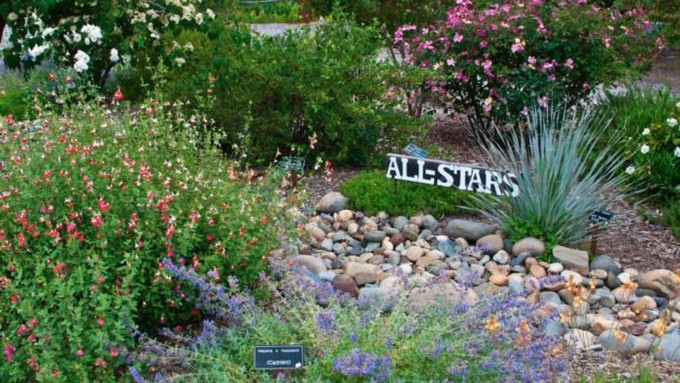
Get advice from master gardeners; plant sales coming soon

The All-Stars area at the Sherwood Demonstration Garden showcases plants designated Arboretum All-Stars by the UC Davis Arboretum -- plants that grow well in our region. Photo courtesy El Dorado County master gardeners
On Friday and Saturday mornings, April 7 and 8, the El Dorado County master gardeners will host Open Garden Days at Sherwood.
“As Master Gardeners, we are committed to educating the general public on sustainable horticulture and pest management practices based on traditional, current, and evolving research,” say the organizers.
“It is our goal that the Sherwood Demonstration Garden will provide the public with a hands-on, interactive experience about research-based, sustainable gardening practices specific to the west slope of El Dorado County, appropriate for all ages and cultures, and reflective of a variety of environments and gardening experiences.”
What will visitors see at Sherwood? “There are 16 individual demonstrations gardens ranging from the Shade Garden to the Rock Garden and everything in between!” say the master gardeners.
During these two mornings, see the master gardeners as they tend their specialties at Sherwood. It’s a great opportunity to ask questions, get advice and learn new skills.
Open Garden Days are 9 a.m. to noon. Admission is free.
Can’t make it this week? The El Dorado County master gardeners will host Open Garden Days every Friday and Saturday in April (as long as the weather stays fine).
On April 15 and 29, enjoy something extra at these events: Spring plant sales! The April 15 sale will feature plants for edible gardening – tomatoes, vegetables, fruit trees, herbs and more. (See the edibles list on the link below. The tomato variety list is two pages long!)
The April 29 sale will focus on ornamentals such as trees, shrubs, grasses, succulents, native and perennial plants.
Sherwood Demonstration Garden is located at 6699 Campus Drive, Placerville.
Details and directions: https://mgeldorado.ucanr.edu/
Comments
0 comments have been posted.Sacramento Digs Gardening to your inbox.
Food in My Back Yard Series
May 6: Maintain soil moisture with mulch for garden success
April 29: What's (already) wrong with my tomato plants?
April 22: Should you stock up on fertilizer? (Yes!)
April 15: Grow culinary herbs in containers
April 8: When to plant summer vegetables
April 1: Don't be fooled by these garden myths
March 25: Fertilizer tips: How to 'feed' your vegetables for healthy growth
March 18: Time to give vegetable seedlings some more space
March 11: Ways to win the fight against weeds
March 4: Potatoes from the garden
Feb. 25: Plant a fruit tree now -- for later
Feb. 18: How to squeeze more food into less space
Feb. 11: When to plant? Consider staggering your transplants
Feb. 4: Starting in seed starting
Sites We Like
Garden Checklist for week of May 11
Make the most of the lower temperatures early in the week. We’ll be back in the 80s by Thursday.
* Plant, plant, plant! It’s prime planting season in the Sacramento area. Time to set out those tomato transplants along with peppers and eggplants. Pinch off any flowers on new transplants to make them concentrate on establishing roots instead of setting premature fruit.
* Direct-seed melons, cucumbers, summer squash, corn, radishes, pumpkins and annual herbs such as basil.
* Harvest cabbage, lettuce, peas and green onions.
* In the flower garden, direct-seed sunflowers, cosmos, salvia, zinnias, marigolds, celosia and asters. (You also can transplant seedlings for many of the same flowers.)
* Plant dahlia tubers.
* Transplant petunias, marigolds and perennial flowers such as astilbe, columbine, coneflowers, coreopsis, dahlias, rudbeckia and verbena.
* Keep an eye out for slugs, snails, earwigs and aphids that want to dine on tender new growth.
* Feed summer bloomers with a balanced fertilizer.
* For continued bloom, cut off spent flowers on roses as well as other flowering plants.
* Add mulch to the garden to maintain moisture. Mulch also cuts down on weeds. But don’t let it mound around the stems or trunks of trees or shrubs. Leave about a 6-inch-to-1-foot circle to avoid crown rot or other problems.
* Remember to weed! Pull those nasties before they set seed.
* Water early in the day and keep seedlings evenly moist.